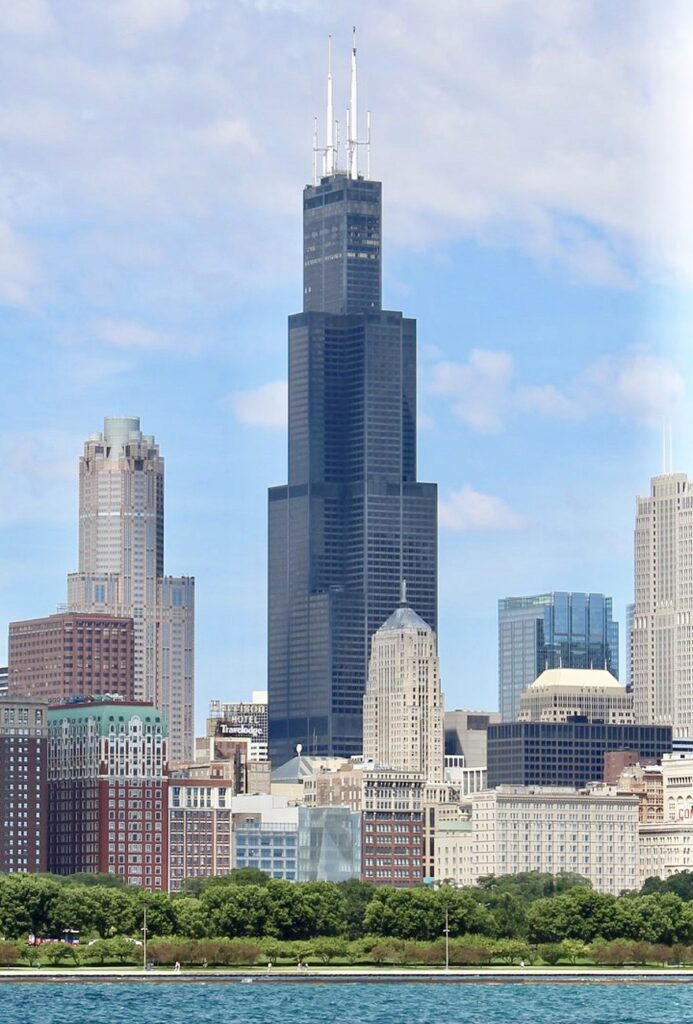
Any first time visitor to Chicago is likely to be overawed by the number of huge skyscrapers which are a prominent feature of the city’s skyline. The city has 130 buildings that are more than 150 metres tall. It is remarkable that architects have designed so many huge and heavy structures which have immense strength and stability, not only at the foundation level but all the way to the top. Despite appearing to be long and thin, they have the strength to withstand gales, hurricanes and earthquakes.
But not many people are aware that an architect from Bangladesh named Fazlur Rahman Khan has designed some of the tallest buildings in Chicago which are also among the tallest in the world. According to the Encyclopedia Britannica, the Bangladesh-born civil engineer who later adopted citizenship of the USA, was famous for his innovations in high-rise building construction and is regarded as the “father of tubular designs.” It was his methods which enabled buildings to be built even taller and stronger.
According to a recent article in The Daily Star newspaper of Dhaka, another reputed Bangladeshi architect named Feroz Alam, inspired by the feats of Fazlur Rahman, is now in the process of designing a 1000 metre tall building.
Fazlur Rahman was born on 3rd April, 1929, in a middle class family. He grew up in the village of Bhandarikandi in Faridpur district of Bangladesh. His father Abdur Rahman Khan was a mathematics teacher in a school who later went on to become Principal of Jagannath College in Dhaka.
Little Fazlur Rahman attended a government school in Dhaka and later studied civil engineering in Shibpur near Kolkata. In 1952 his life took a dramatic turn. He received a Fulbright scholarship and a government grant, which enabled him to travel to the United States. There he studied at the University of Illinois at Urbana-Champaign. In three years, Khan earned two master’s degrees – one in structural engineering and one in theoretical and applied mechanics. Then he obtained a PhD in structural engineering. He earned the nickname of “the Einstein of structural engineering.”
So it was that the little boy from a Bangladesh village, son of a schoolmaster, reached great heights in his field, all by using his talent and hard work. What was even more astonishing was that Fazlur Rahman had not seen a skyscraper till he was himself 21 years old. The tallest buildings in Dhaka were usually three or four stories high at that time.
His qualifications enabled him to join the prestigious architectural firm of Skidmore, Owing & Merrill in Chicago in 1955 and within ten years, he became a partner. At the time, ground space was becoming very limited in cities like New York and Chicago. Architects were therefore attempting to construct upwards instead of expanding horizontally.
It was while toying with ideas to construct buildings which were taller than ever before, that Fazlur Rahman came up with his innovations of tubular designs which reinforced the strength of the structures. One of Khan’s most important variants of the tube structure concept was the bundled tube, which was used for the Sears Tower (now called Willis Tower) which is 1,451 feet high and was the world’s tallest building for 25 years before being overtaken.

The famous Sears Tower was where Fazlur Rahman first implemented the “bundled tube” structural system wherein a group of narrow steel cylinders are clustered together to form a thicker column.
The building named One Magnificent Mile in Chicago and the 1,128 feet high John Hancock Center were also built along the same lines. Khan and Mark Fintel conceived shock absorbing structures for protection against strong earthquakes.

According to an article in The Independent, “Khan’s radical rethinking of how skyscrapers were structured proved a game-changer, allowing far taller buildings to be realised.” Other notable structures designed by him include the US Bank Center in Milwaukee, One Shell Square in New Orleans, 140 William Street in Melbourne and the Hajj Terminal at the King Abdulaziz International Airport in Jeddah, Saudi Arabia.” The Hajj Terminal received the Aga Khan Award for Architecture in 1983.
Fazlur Rahman’s work has been appreciated in public by US Presidents Bill Clinton and Barak Obama. On June 15, 1998, Clinton wrote a letter honouring the achievements of Fazlur Rahman Khan: “Drawing on the richness of his Bengali background and the vigor and energy of American culture, Fazlur Khan pushed the boundaries of modern architecture and dramatically changed the physical landscape of the great city of Chicago.”
His daughter Yasmin Sabina Khan, also a well known architect, has written: “My father had a talent for making learning fun, and he seems to have been able to infuse work at Skidmore Owing & Merrill with interest and enjoyment in a similar fashion. When I was writing my book about him titled Engineering Architecture: The Vision of Fazlur R. Khan, the stories I heard from his former colleagues consistently recalled this aspect of working with my father.”
The Independent’s article goes on to quote the architect as saying: “The technical man must not be lost in his own technology. He must be able to appreciate life, and life is art, drama, music, and most importantly, people.” Khan was a man who appreciated many things. He was a lover of music especially the songs and poems penned by the famous Bengali author, poet and songwriter Rabindranath Tagore. Unfortunately Khan did not live long. He passed away due to a heart attack at the age of 52 when on a trip to Jeddah in 1982.
Abhijit Sen Gupta is a seasoned journalist who writes on Sports and various other subjects.

